
Liquidity analysis: a glance at some fundamentals
Here’s a quick breakdown of our method for examining standard metrics and the information we use to assess market liquidity gaps.
As market makers, we continuously spotlight opportunities for our partners by rigorously analysing certain liquidity parameters in today’s market. This piece offers a glimpse into the metrics we review and the data we assess to pinpoint gaps in market liquidity. This analysis is routinely performed to provide our partners with a detailed snapshot of their tokens’ liquidity health.
Three Focus Metrics
Although our daily operations involve reviewing numerous metrics, for clarity, we’ll focus on three key metrics we use to gauge market health.
When observing CEXs, we first focus on volumes. We aim to distinguish how much of each CEX volume is organic volume flowing through the markets and how much is being wash-traded.
Next, we assess how much liquidity is found in each exchange; specifically, we look into the 2% depth of the market. It represents the liquidity available in the order book at a price 2% away from the current market price. We regard this figure as a benchmark, integral for assessing market depth and ensuring price stability. By examining the current liquidity on the exchange, we’re able to judge whether it possesses the capacity to absorb its average daily trading volumes.
Lastly, we investigate the distribution of liquidity at different levels within each exchange and examine the most liquid pairs associated with the token we’re assessing. This allows us to identify the centralised exchanges (CEXs) that would benefit most from added liquidity and the optimal pairs for trading.
By combining these three market snapshots, we have a comprehensive understanding of the market’s overall health. This overview allows us to spot potential market gaps and strategically support our partners by providing liquidity where they need it most.
For this specific analysis, we have looked at the following CEXs: Binance, Bitstamp, Bybit, Coinbase, Crypto.com, Gate, Huobi, Kraken, and Okex.
ETH’s liquidity distribution among CEXs
To illustrate our process with tangible data, we’ll use Ethereum as an example.
1. Volume Analysis
We examine the volume across CEXs, assessing the amount of organic volume that flows through the market using multiple metrics. We evaluate these parameters to check how much of the market’s volume is organic.
While analysing ETHUSDT’s volume per exchange, we observe that out of a total of 546 million USD of volume in 1 day, 87% can be labelled as organic (472 million USD). This can be attributed to ETH’s market maturity and competitiveness among parties, making it a very healthy and liquid market.
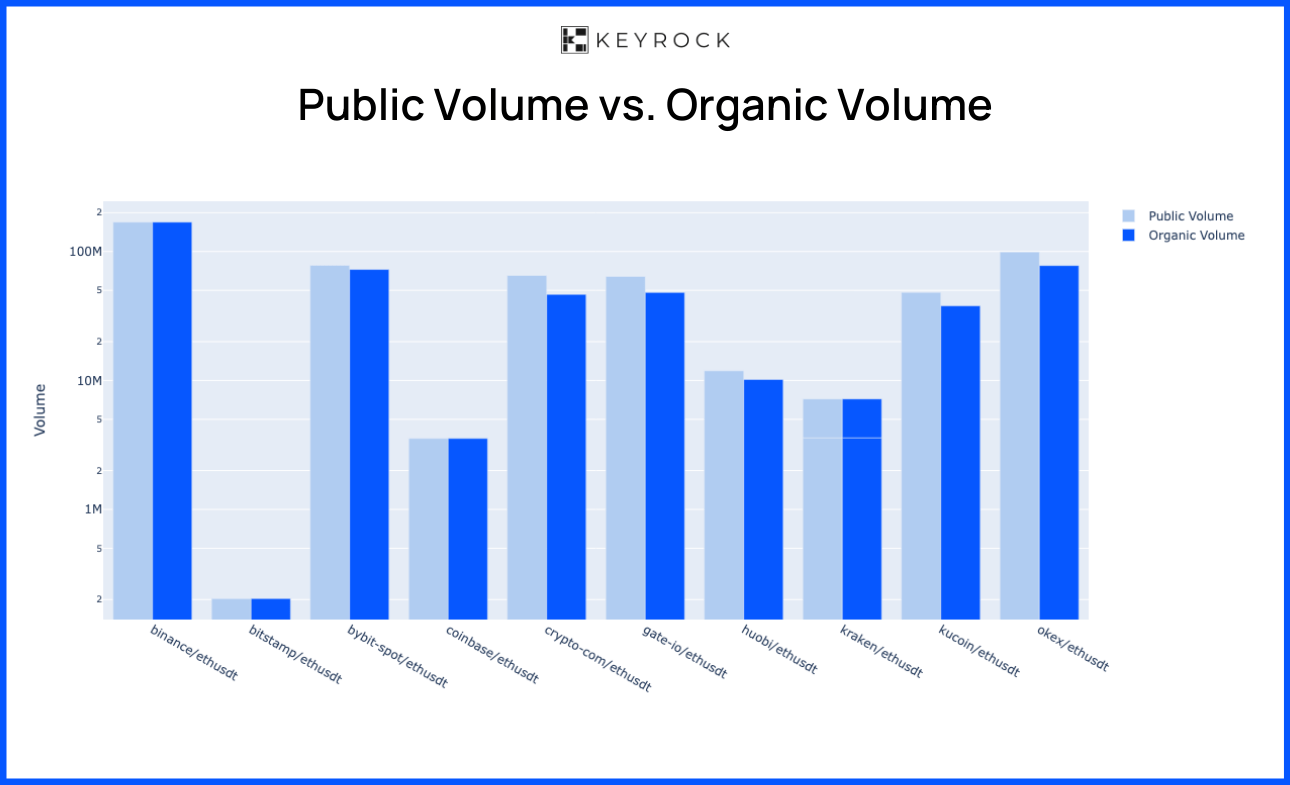
Comparison across CEXs of their organic vs total volume.
We observe similar numbers across other ETH markets, like ETH/BTC or ETH/USD, where around 85 to 90% of the volume across exchanges can be labelled organic.
However, while ETH markets are healthy, we have spotted instances where other markets, especially those involving tail assets, show significantly lower organic volume—several times less than the publicly disclosed figures—once we eliminate the non-organic activity.
2. Liquidity at 2% depth
Next, we look at depth within a 2% range. In this case, if BTC trades at $40,000, the +- 2% price is $39,200-$40,800. The more liquidity is available, the easier it is to facilitate larger orders, preventing price slippage and ensuring more efficient market operations.
We define the expected liquidity of a market as the predicted amount of funds needed to support the current volume of trading activity for each market. Markets with low liquidity tend to deter traders, as the lack of liquidity signals low trading activity and difficulty entering/exiting their position.
On ETH, we observe that all exchanges have sufficient liquidity to support daily average volumes, as the “Current Liquidity Available” exceeds the “Expected Liquidity.” However, Crypto.com misses approximately ~$100k in liquidity. Based on this analysis, they’re the only exchange with a less efficient liquidity flow.
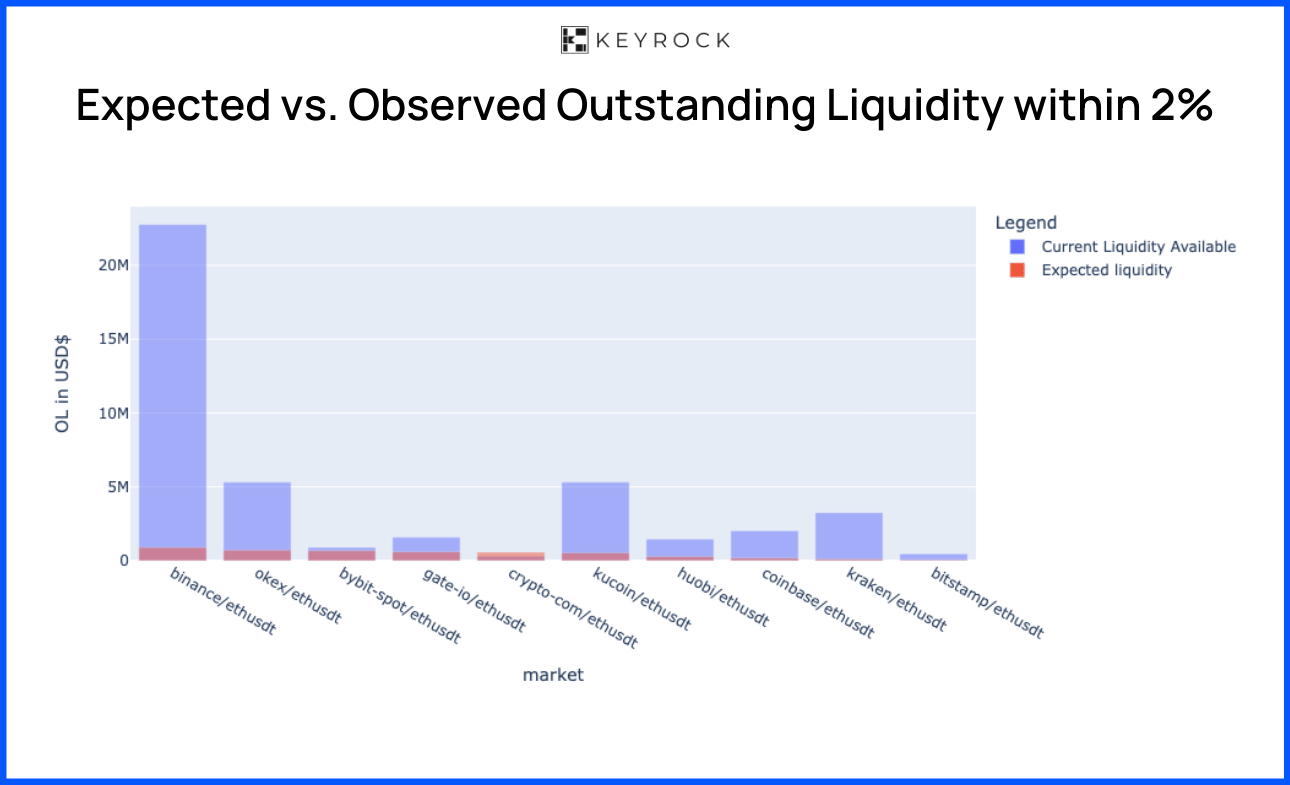
Expected vs. current liquidity available across various CEXs at a 2% price level.
3. Liquidity Distribution
Lastly, we analyse how liquidity is distributed across depth using the following range: 0.1%, 0.2%, 0.5%, 1%, and 2% on CEXs. By looking at these different levels, we can gain insights into how liquidity spreads across different price points. This helps us assess the market’s resilience and stability.
Binance emerges as the most liquid exchange, with around $35 million available at 2% across all pairs, making it the exchange with the most liquidity at the 2% level. Close to Binance, we find Coinbase and Kraken with $23 million and $21 million respectively.

Liquidity comparison across depths for different CEXs.
Now, let’s observe which pair has the most liquidity available for ETH by looking again at the 2% Depth. From our analysis, see below, USDT has $43 million available at 2% across all pairs, followed by USD with $26 million and BTC with $17 million, highlighting that most trades comfortably settle against those pairs. On the contrary, GBP does not have as much liquidity, signalling that few traders want to trade ETH against GBP.
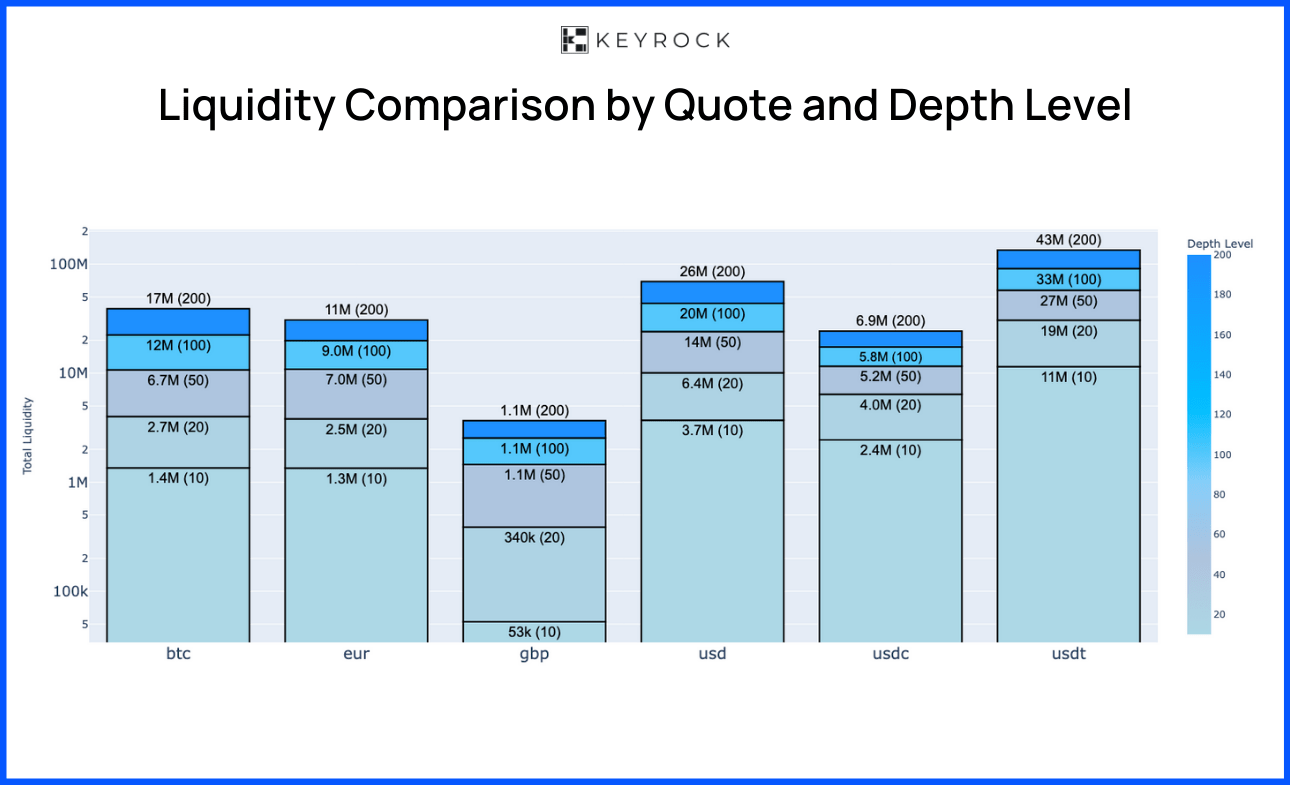
Liquidity comparison by pair asset aggregating the liquidity across depths for different CEXs.
ETH’s Liquidity in Uniswap
In addition to analysing liquidity throughout CEXs, we review liquidity across the different relevant on-chain venues (DEXs). Given our status as a crypto-native market maker, we keep a keen eye on the evolution of the DeFi space. Here’s an insight into how we go about assessing liquidity on decentralised exchanges.
We’ll use Uniswap as an example, given that it’s the largest DEX not only in the Ethereum ecosystem but across all chains. Similarly to our analysis on CEXs, we want to have the full picture of which pools are the most liquid, how the token distribution within the pools is, and how much volume is being settled on those.
Most Liquid Pools for Uniswap V3
Thousands of pools exist on Uniswap, so we’ll be selective. To simplify the data presented below, we will concentrate on the top 5 pools with the highest liquidity. These pools account for $550 million in liquidity — of those, $305 million worth of ETH is deposited along with $245 million of pair assets. Notably, the wBTC/wETH pool is roughly 40% of the overall liquidity of these 5 pools.
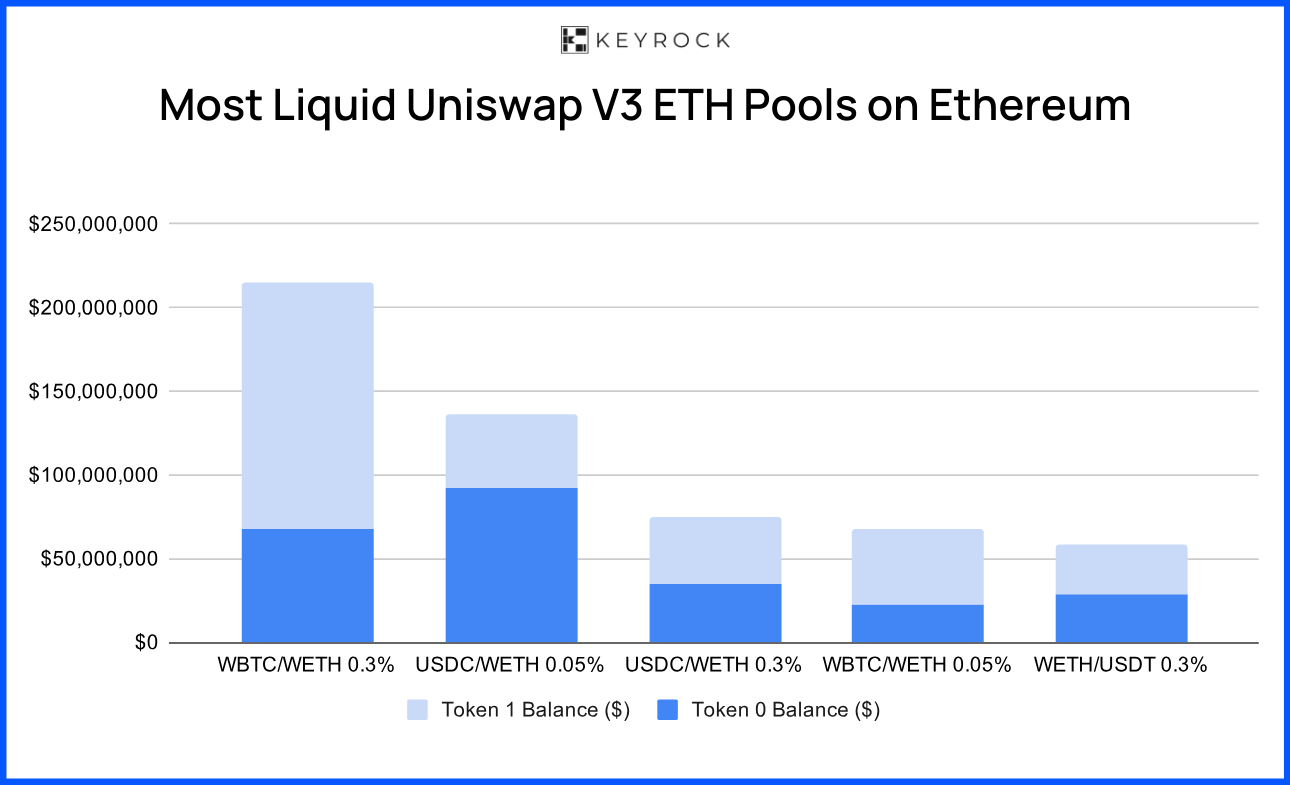
Most liquid pools on Uniswap V3 for ETH (wETH) pairs. Source: Flipside, @Keyrock.
Liquidity Distribution on USDC/wETH
Let’s focus on the USDC/wETH 0.05% pool, as the ETH/USDT and ETH/USDC are fairly popular assets on CEX. This allows us to make a fair comparison between the two.
Until the beginning of January 2024, of the liquidity, around 67% sits on USDC (token_0), implying most of the liquidity is below the current ETH price. This implies that a dip in ETH could see these USDC holdings acting as de facto buy orders, hinting at anticipation of a price decrease.
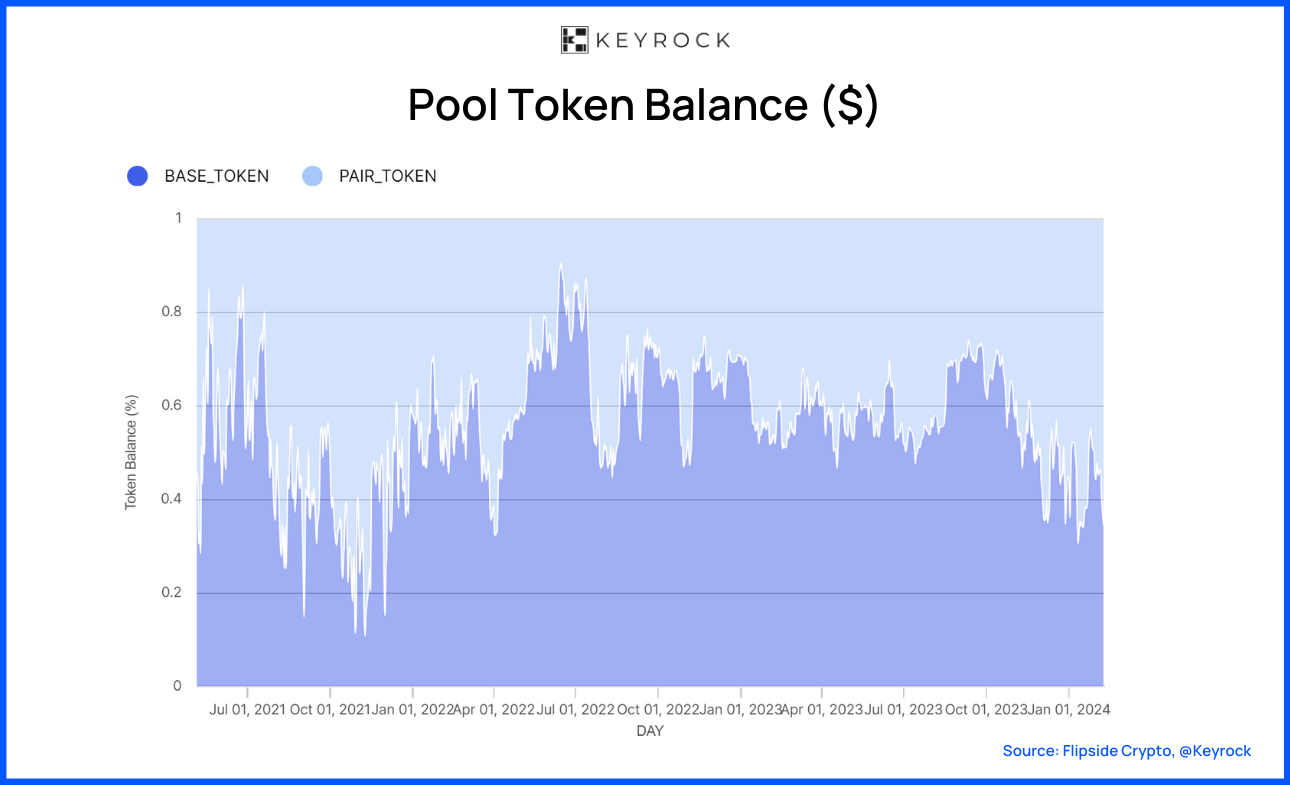
Source. Flipside Crypto, @Keyrock.
When checking for the tick distribution, still considering the 2% Depth benchmark, we observe that around 15% of the liquidity is concentrated at this level. This translates to $20 million of liquidity being available within a 2% price deviation. A depth of liquidity within such a narrow price range indicates robust support levels and facilitates smoother accommodation of large orders.
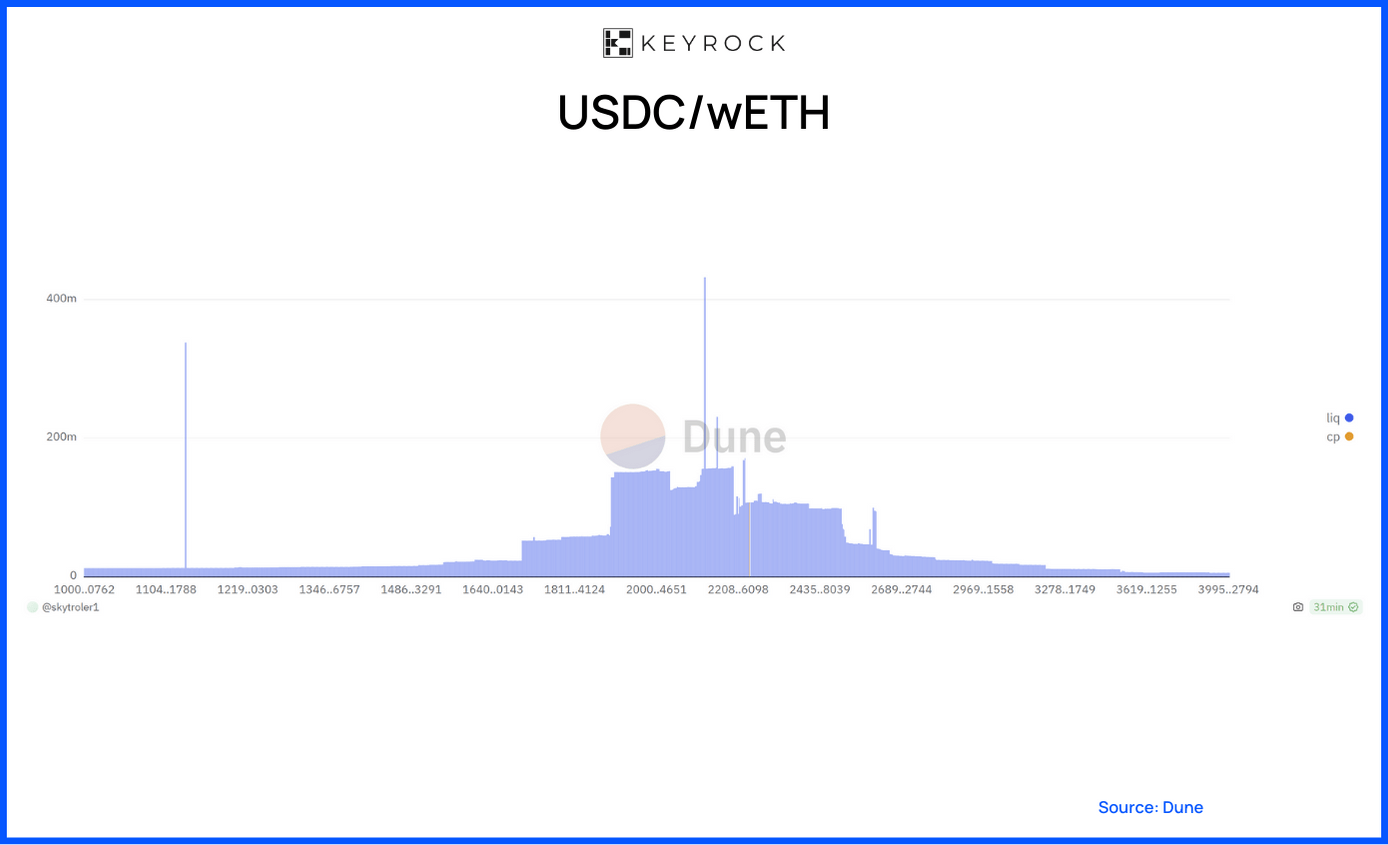
Conclusions
Unsurprisingly, the CEX liquidity landscape for ETH is notably robust, with a significant amount of the volume (87%) being organic. We observe that across most Tier-1 exchanges, there’s sufficient liquidity to support the daily volumes–of $600+ million just on ETH.
We also observe that, at the moment of our analysis, Binance is the most liquid exchange, followed by Coinbase and Kraken. Those who are largely concerned about CEX reserves after FTX’s downfall can check an aggregated view on DeFi Llama.
The liquidity across various depths is pretty strong and significant across exchanges. The most popular trading pair for ETH is USDT, with $43 million readily available at a 2% depth across CEXs.
On the other hand, data on DEXs shows that Uniswap is the main leader in liquidity for ETH, with the most preferred fee tier at 0.3%. Examining the two most liquid pools for ETH, the wBTC/wETH 0.30% and USDC/wETH 0.05% pools, we note that around $35 million in liquidity is available in those price ranges out of the combined $350 million.
This liquidity sits at a very similar level to the liquidity we found present on CEXs, indicating we’re in an efficient market where dislocations CEX-DEX are not that easy to come by.
Finally, while the Ethereum market has outstanding liquidity, as mentioned above, some markets are not as healthy, especially for long-tail and low-liquidity assets.
Read more: Scaling up our onchain operations
- Looking for a liquidity partner? Get in touch
- For our announcements and everyday alpha: Follow us on Twitter
- To know our business more: Follow us on Linkedin
- To see our trade shows and off-site events: Subscribe to our Youtube

